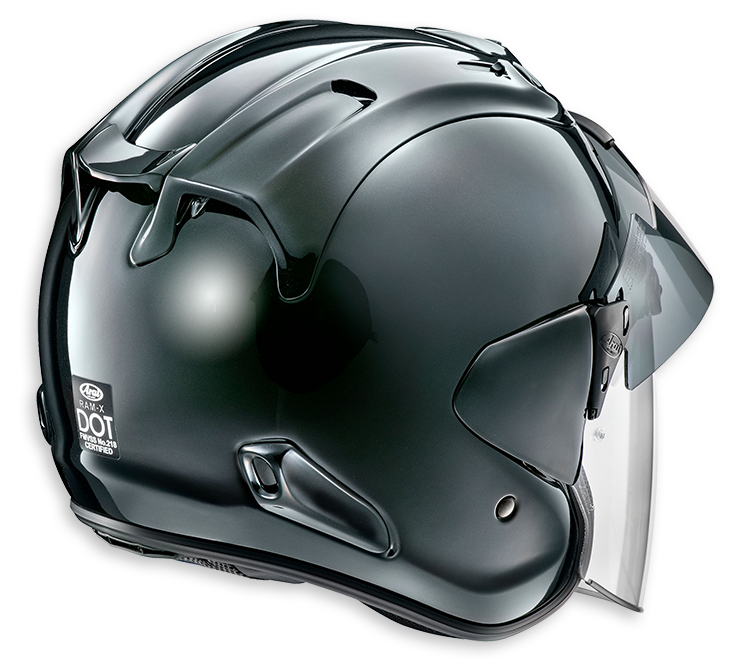Riding
Panoramic Views
Different Approaches To Open-Face Protection
Hoteliers hype a room with a view—a breathtaking sunset, the scent of flowers in season, a clifftop overlook—but nothing rivals the unobstructed perspective of the road ahead from the seat of a motorcycle.
The Arai Ram-X, launched in 2019, and the Shoei J-Cruise II, revised this year, are modern riffs on traditional open-face helmet design. Similar in concept, they differ in execution.
Both helmets have hand-laid fiberglass shells manufactured with proprietary materials. Both are DOT certified; the Arai adds Snell endorsement. Both have customizable interiors, removable for cleaning and replacement; cheek pads are eyeglasses-compatible and are available in different thicknesses. And both have three-position—two open and fully closed—intake vents that can be adjusted while wearing riding gloves.
What are the differences?
The Ram-X is fitted with a one-piece molded liner, the density of the polystyrene beads used to create the liner selected to enhance energy absorption. The J-Cruise II also has a multi-density liner. Its two-piece construction is designed to allow air to travel unrestricted through pathways created in the expanded polystyrene.

▲ Arai Ram-X in Gun Metallic Frost.
Arai secures the Ram-X with a customary double D-ring assembly. Shoei uses a patented ratcheting chin strap with a sturdy stainless steel locking mechanism; a separate D-ring allows the helmet to be locked to a motorcycle.
Long, wide, flip-up shields cover areas of the face that otherwise would be exposed to the elements.
The Ram-X incorporates a modification of the Variable Axis System seen on Arai’s X-series full-face helmets. VAS lowers the shield pivot point so the upper portion of the shell can be smoother and, ostensibly, less likely to snag on foreign objects in a crash. Arai refers to this as “glancing off.”
Despite the engineering challenges this design presented, the Ram-X shield opens and closes without directly contacting the shell or the Corsair-X-style diffusers. A lever built into the VAS mechanism releases the shield for removal.
The Ram-X comes with Arai’s unique VAS-Z Pro Shade System that layers a shorter tinted shield over the full-length clear shield to manage different light conditions. VAS-Z shields also are available without the Pro Shade System in clear, dark or light tints, as well as mirrored options.
Shoei took a different approach with the J-Cruise II, fitting an internal drop-down sun shield, like those used on the full-face GT-Air II and modular Neotec II. Raised and lowered with a ribbed slider on the left side of the helmet, the QSV-2 is 5mm longer than the previous version, is removable for cleaning or replacement and is claimed to exceed the ANSI standard for nonprescription eyewear.

▲ Shoei J-Cruise II in white.
In addition, Shoei sells a small visor, fitment of which requires a different face shield. Shoei shields are injection molded for optical clarity.
The Ram-X accepts a Corsair-X-derived DF-X2 spoiler that mates to the diffuser exhaust ports at the back of the helmet. Both the Ram-X and the J-Cruise II shields are prepped for Pinlock fog-resistant insert lenses.
For those riders who want to talk with others or listen to music on rides, the J-Cruise II is compatible with Sena SRL2 communication systems. The unit snaps into the base of the shell on the left side of the helmet and is controlled with three buttons.
The Ram-X retails for $679.95 and is available in Modern Gray, Gun Metallic Frost, Diamond White, Black Frost, Aluminum Silver, Diamond Black or, for $10 more, Florescent Yellow, in XS–XXL sizing.
The J-Cruise II retails for $549 and is offered in five colors—Anthracite Metallic, Matte Blue Metallic, Matte Black, black or white—in XS–XXL.
Which one of these helmets is right for you, the Arai Ram-X or the Shoei J-Cruise II? That is for you to decide. Regardless of your choice, you will see all there is to see.




